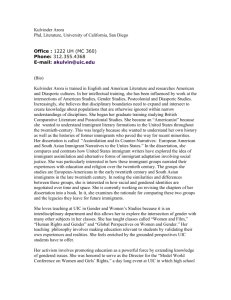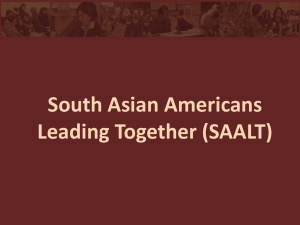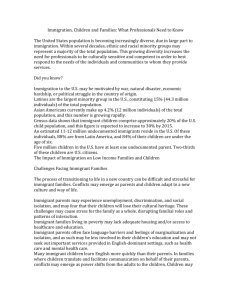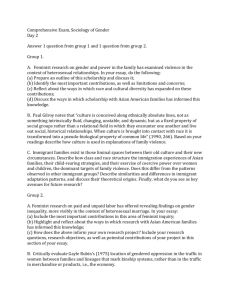Immigration and Diaspora
advertisement
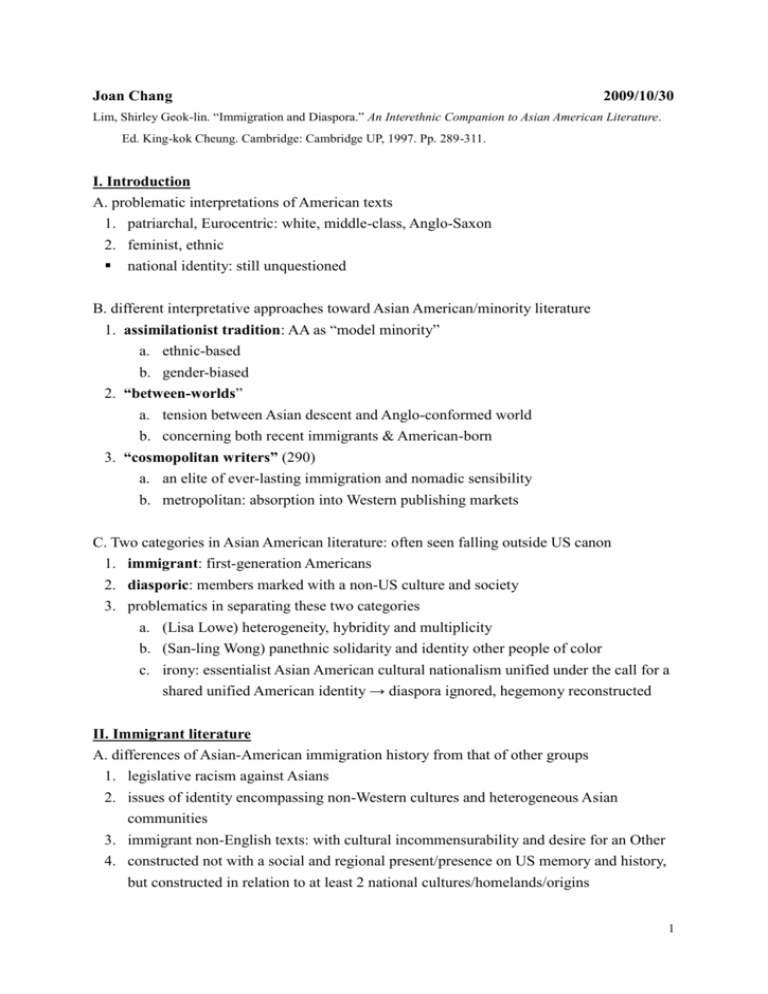
Joan Chang 2009/10/30 Lim, Shirley Geok-lin. “Immigration and Diaspora.” An Interethnic Companion to Asian American Literature. Ed. King-kok Cheung. Cambridge: Cambridge UP, 1997. Pp. 289-311. I. Introduction A. problematic interpretations of American texts 1. patriarchal, Eurocentric: white, middle-class, Anglo-Saxon 2. feminist, ethnic national identity: still unquestioned B. different interpretative approaches toward Asian American/minority literature 1. assimilationist tradition: AA as “model minority” a. ethnic-based b. gender-biased 2. “between-worlds” a. tension between Asian descent and Anglo-conformed world b. concerning both recent immigrants & American-born 3. “cosmopolitan writers” (290) a. an elite of ever-lasting immigration and nomadic sensibility b. metropolitan: absorption into Western publishing markets C. Two categories in Asian American literature: often seen falling outside US canon 1. immigrant: first-generation Americans 2. diasporic: members marked with a non-US culture and society 3. problematics in separating these two categories a. (Lisa Lowe) heterogeneity, hybridity and multiplicity b. (San-ling Wong) panethnic solidarity and identity other people of color c. irony: essentialist Asian American cultural nationalism unified under the call for a shared unified American identity → diaspora ignored, hegemony reconstructed II. Immigrant literature A. differences of Asian-American immigration history from that of other groups 1. legislative racism against Asians 2. issues of identity encompassing non-Western cultures and heterogeneous Asian communities 3. immigrant non-English texts: with cultural incommensurability and desire for an Other 4. constructed not with a social and regional present/presence on US memory and history, but constructed in relation to at least 2 national cultures/homelands/origins 1 5. memory and history: often socialized but not privatized or psychologized (292) 6. in ethnographic discourse B. reasons 1. AA as recent immigrants a. pulled by economical and political motives (in both Asia and US) b. pushed by discriminatory legislation 2. AA Studies: interdisciplinary but with less issues on convergence of race with national identity C. “internal colonialism”: Asians as needed workers but unwanted aliens 1. Immigrants are contested and weakened. 2. Literature to interrogate concepts of identity, home and nation III. Both Immigrant & Diasporic A. (Edward Said) “Secular Criticism”: dialectic of filiation and affiliation 1. filiation: natal relations, natural, situated in the capacities to produce/generate children 2. affiliation: social relations, from institutions, associations and communities (294) B. examples 1. showing tensions, shifting relations between diasporic and immigrant social formations a. Chinese poetry carved on the walls of the Angel Island detention barracks b. Cantonese poems published in US Chinatown newspapers Manifestations on the AA women’s bodies: showing conflicting and contradictory cultural values 2. showing assimilationist models a. (Pardee Lowe) Father and Glorious Descendent b. (Jade Snow Wong) Fifth Chinese Daughter Diasporic subject = subject to the amnesiac condition of the “new American” Repeating orthodox myths C. Incorporating filiation and affiliation: 1. immigration: outside the natal order, usually constructed in assimilative narratives, integrated into an affiliative order 2. exile: in/voluntary separation from one’s birth place, with continued bonds to the lost homeland and nonintegration into the affiliative order 3. diaspora: deprived of the affiliation of nation, fragmented in demonstrating provisionality and exigency 2 a. disarticulation of identity from natal and national resources b. deterritorialization of language and imagination transnational, ex-colonial or postcolonial literature IV. shifting from discourse of immigration to that of diasporas A. Global culture with technological innovation 1. discourse of immigration shifted to discourse of diasporas 2. renewed state efforts to control/patrol physical and cultural borders vs. national distinctiveness threatened by uncontrollable change/influence from “alien” cultures (298) B. Global publishing industry 1. Print capitalism: a. (past) laying the bases for national consciousness b. (present) laying the bases for transnational consciousness that undermines national consciousness 2. diaspora literature: metropolitan across borders a. highly marketable products which rethematizes Western cultural hegemony b. creating an imagined community of interpretation Western metropolitan-based c. open to contradictory interpretations i. interrupting and challenging the hegemony of metropolitan cultures ii. viewing its popular publication and reception as dispersal of strangeness and naturalization/nationalization of the alien d. nationalistic appropriation: flawed and essentially ethnocentric vision e. “global literature”: different from “world literature” C. comparing nonaffiliative and affiliative: 1. nonaffiliative (by diasporic Chinese writers): a. an act of deterritorialization, critiquing both Chinese and American historical and cultural hegemony b. resisting US civilization 2. affiliative (by second-generation writers): a. text of assimilationary themes b. US society desirable, fetishistically possessable and utopian D. international culture based on capital 1. with a-filiative sensibility: absent of natal home, void of origin 2. with no traditional place or national boundaries 3 (result) origin/China: void = construction of the metropolis/US: material vitality E. from immigrant to diasporic 1. Typical American: set in US but should not be read as a whole US work a. immigrant vision: US of endless invention, material possibilities → cultural fantasy b. promise of American capital vs. limit of human ability (301) c. composing a fiction of contradictory values in immigrant disocurse 2. Kitchen God’s Wife: set in China but read as a US text a. China: a third world imagined with raw monstrous materials b. marketable for its affiliative grid: Western feminism, ethnic identity/class, etc. c. appropriating the Orients for American national purposes V. questioning monolithic US-identified Asian American identity A. (Indo-American literature) Bharati Mukherjee: immigrant and assimilationist paradigm 1. advocating historical amnesia: with no history prior to immigration 2. repivileging the myth of America as the unhindered/sovereign individual 3. denouncing exilic, with colonial duality: to appropriate third world materials and to encourage root-pulling 4. Jasmine (1989): reproducing the hegemonic epic o the US as the nation of limitless opportunity, freedom and individualism B. (Pilipino American literature) Oscar Campomanes: exilic paradigm 1. postcolonial and neocolonial produced discourse with an exilic tradition 2. a historically oppositional construction of identity validated only outside US borders 3. problematizing an American-born sensibility 4. Bienvenido Santos: Pinoy/1st-generation Filipino American as an existentialist condition a. in but not of America b. neither expatriate nor immigrant, always shifting inhabitants (305) c. reproducing social relations in an urban, distant and individual culture prevailing with nostalgia and homesickness d. problematics of cultural desire: Filipino exilic desire and US assimilationary desire →paradigm of “between world” C. historically shifting, heterogeneous processes of identity formation: questioning any hegemonizing theoretization or orthodoxies. 4
